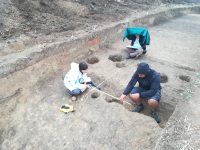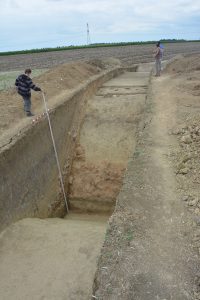Archaeologists have unearthed the remains of a massive Bronze Age citadel in the town of Sântana, Arad county, north-western Romania. An international team of German and Romanian archaeologists has been excavating the site, first explored in 2009, for two years and only a small fraction of it has been exposed. More than half of the site has been measured and mapped extensively via magnetic survey, however. Out of 90 hectares, 55 have been documented magnetometrically, allowing the team to map the fortress from outer defenses to the citadel’s main structures.
in the town of Sântana, Arad county, north-western Romania. An international team of German and Romanian archaeologists has been excavating the site, first explored in 2009, for two years and only a small fraction of it has been exposed. More than half of the site has been measured and mapped extensively via magnetic survey, however. Out of 90 hectares, 55 have been documented magnetometrically, allowing the team to map the fortress from outer defenses to the citadel’s main structures.
 The fortress was enclosed by a moat more than 13 feet deep outside of an earth rampart an estimated 70 feet high. These intimidatingly looming ramparts protected a palace in the interior. This massive structure was about 330 feet long and 130 feet wide. The palace and other structures inside the citadel were made of mud/clay and wood.
The fortress was enclosed by a moat more than 13 feet deep outside of an earth rampart an estimated 70 feet high. These intimidatingly looming ramparts protected a palace in the interior. This massive structure was about 330 feet long and 130 feet wide. The palace and other structures inside the citadel were made of mud/clay and wood.
Rüdiger Krause, professor at the Goethe University in Frankfurt, and Romanian professor Florin Gogâltan, from the Institute of Archeology and History of Art of the Romanian Academy in Cluj-Napoca, came to the conclusion that the “Old Citadel” in Sântana was built in the 14th century BC, about 3,400 years ago.
“The citadel in Sântana is one of the largest fortifications built during the mentioned period. Our purpose is to find out why this fortification was made, why this construction was needed,” the German professor said, according to Aradon.ro.
The discoveries also made the archeologists believe that the “Old Citadel” in Romania is much bigger than the ancient city of Troy.
“Troy had an area of 29 hectares, the Citadel in Sântana covers 89 hectares. The buildings of Troy were made of stone. At Sântana, the buildings were made of clay and wood, a sign that civilization was more developed and adapted to the building materials it had,” Florin Gogâltan explained. “We are facing one of the biggest and impressive fortresses in Europe.”
 And they want to give it its due. The director of the Arad Museum is advocating the construction of a new museum in Sântana on the site itself. The entirety of the site is not likely to be fully excavated — the current German-Romanian project is slated to last one more year only — but what has been revealed is in excellent condition. Local government officials are very much into the idea of creating a tourist attraction that would bring an infusion of cash to the area as well as international recognition of this unique and highly significant archaeological treasure.
And they want to give it its due. The director of the Arad Museum is advocating the construction of a new museum in Sântana on the site itself. The entirety of the site is not likely to be fully excavated — the current German-Romanian project is slated to last one more year only — but what has been revealed is in excellent condition. Local government officials are very much into the idea of creating a tourist attraction that would bring an infusion of cash to the area as well as international recognition of this unique and highly significant archaeological treasure.